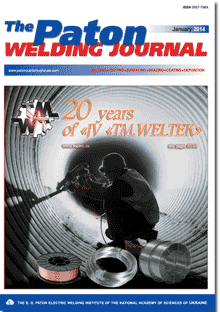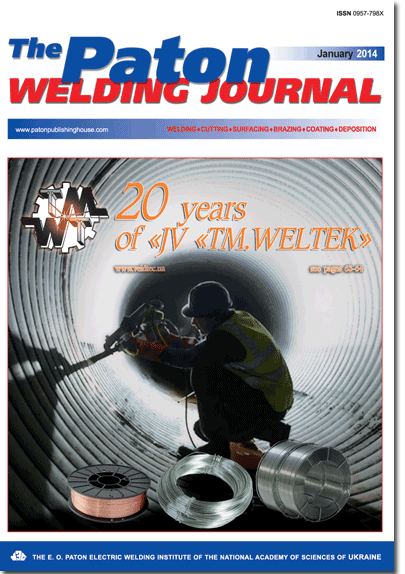| 2014 №01 (06) |
DOI of Article 10.15407/tpwj2014.01.07 |
2014 №01 (08) |

The Paton Welding Journal, 2014, #1, 46-50 pages
CALCULATION OF UPSETTING FORCE IN FLASH BUTT WELDING OF CLOSED-SHAPE PRODUCTS
P.N. CHVERTKO, A.V. MOLTASOV and S.M. SAMOTRYASOV
E.O. Paton Electric Welding Institute, NASU. 11 Bozhenko Str., 03680, Kiev, Ukraine. E-mail: office@paton.kiev.ua
Abstract
In structure elements of flying vehicles the ring-type parts of high-alloy steel and alloys are widely applied. To manufacture such structure elements different methods of fusion welding are applied including flash butt welding (FBW). Technology of FBW of such parts requires high upsetting speeds У50mm/s with a specific force of not less than 120-200 MPa. In FBW of parts of a closed shape it is important to determine the value of necessary upsetting force. At unlimited or insufficient upsetting force the necessary conditions for joint formation in a solid phase will not be provided, and during overheating the part shortening will be rather large. Both conditions will lead to violation of shape of ring-type parts, in particular, in perimeter. In the process of welding the elastic forces appear in product being welded, hindering the joint formation, which should be determined in the development of technology and equipment for welding. Besides, in welding of ring-type billets of a large section, which are characterized by a significant elasticity, it is necessary to take into account the possibility of a welded butt rupture due to elasticity of billet at insufficient time of upsetting without passing of electric current. Calculation of the above-mentioned forces was carried out according to the theory of thin rods under the conditions, when stress-strain state was considered to be linear. Also the calculation of given forces using the methods of elasticity theory was carried out, and as a result the plain problem of elasticity theory was solved. The comparison of results of calculation of eight rings with different characteristic sizes showed that maximum difference of values of upsetting force, calculated by the theory of thin rods and formulae of plane problem, was about 2 %, and the values of forces, rupturing a butt after welding, was less than 1 %. Moreover, in decrease of ratio of external radius of the ring to its internal radius the accuracy of calculation according to the theory of thin rods is increased. 7 Ref., 1 Table, 4 Figures.
Keywords: flash butt welding, rings, high-alloyed steels, stress-strain state, upsetting force, theory of thin rods, plain problem
Received: 25.08.13
Published: 28.01.14
References
1. Kuchuk-Yatsenko, S.I. (1992) FBW. Kiev: Naukova Dumka.
2. Kuchuk-Yatsenko, S.I., Chvertko, P.N., Semyonov, L.A. et al. (2013) FBW of products of high-strength alloys based on aluminium. The Paton Welding J., 7, 2-6.
3. Kuchuk-Yatsenko, S.I., Didkovsky, V.A., Bogorsky, M.V. et al. Method of resistance butt welding. Pat. 46820 Ukraine. Publ. 17.06.2002.
4. Pisarenko, G.S., Yakovlev, A.P., Matveev, V.V. (1975) Handbook on strength of materials. Kiev: Naukova Dumka.
5. Lurie, A.I. (1970) Theory of elasticity. Moscow: Nauka.
6. Timoshenko, S.P., Goodier, J.N. (1975) Theory of elasticity. Moscow: Nauka.
7. Kochergin, K.A. (1952) Selection of technology of resistance welding. Leningrad: Sudpromgiz.
Suggested Citation
P.N. CHVERTKO, A.V. MOLTASOV and S.M. SAMOTRYASOV (2014) CALCULATION OF UPSETTING FORCE IN FLASH BUTT WELDING OF CLOSED-SHAPE PRODUCTS. The Paton Welding J., 01, 46-50.The cost of subscription/purchase order journals or individual articles
| Journal/Currency | Annual Set | 1 issue printed |
1 issue |
one article |
| TPWJ/USD | 384 $ | 32 $ | 26 $ | 13 $ |
| TPWJ/EUR | 348 € | 29 € | 24 € | 12 € |
| TPWJ/UAH | 7200 UAH | 600 UAH | 600 UAH | 280 UAH |
| AS/UAH | 1800 UAH | 300 UAH | 300 UAH | 150 UAH |
| AS/USD | 192 $ | 32 $ | 26 $ | 13 $ |
| AS/EUR | 180 € | 30 € | 25 € | 12 € |
| SEM/UAH | 1200 UAH | 300 UAH | 300 UAH | 150 UAH |
| SEM/USD | 128 $ | 32 $ | 26 $ | 13 $ |
| SEM/EUR | 120 € | 30 € | 25 € | 12 € |
| TDNK/UAH | 1200 UAH | 300 UAH | 300 UAH | 150 UAH |
| TDNK/USD | 128 $ | 32 $ | 26 $ | 13 $ |
| TDNK/EUR | 120 € | 30 € | 25 € | 15 € |
AS = «Automatic Welding» - 6 issues per year;
TPWJ = «PATON WELDING JOURNAL» - 12 issues per year;
SEM = «Electrometallurgy Today» - 4 issues per year;
TDNK = «Technical Diagnostics and Non-Destructive Testing» - 4 issues per year.


